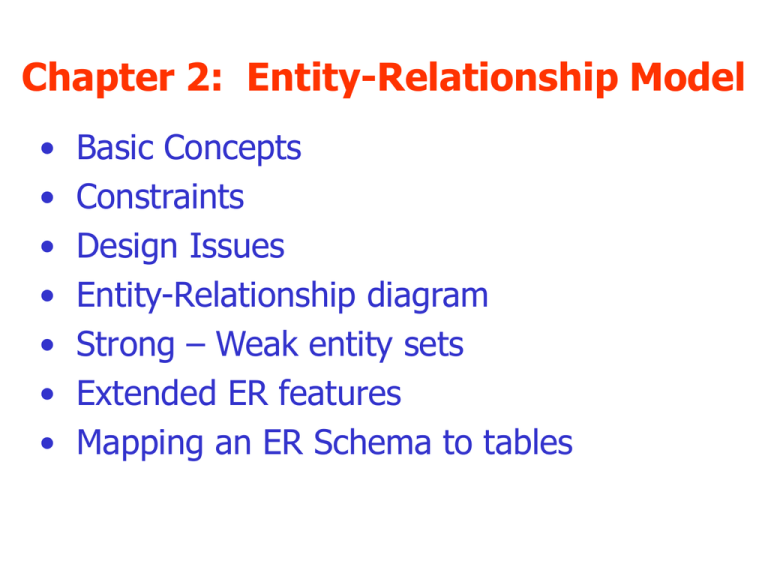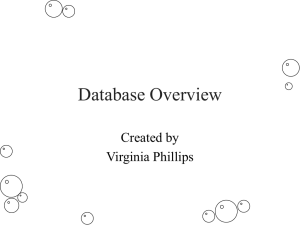
Chapter 2: Entity-Relationship Model
•
•
•
•
•
•
•
Basic Concepts
Constraints
Design Issues
Entity-Relationship diagram
Strong – Weak entity sets
Extended ER features
Mapping an ER Schema to tables
Entity-Relationship Model
ER modeling: A graphical technique for
understanding and organizing the data
independent of the actual database
implementation OR
The ER model describes data as entities ,
relationships and attributes
A technique used to analyze & model the data in
organizations using an Entity Relationship (E-R)
diagram.
• Basic Notations of ER model are
• Entity types / sets
• Relationship types / sets
• Attributes
Entity Types , Entity Sets, Keys
and Value Sets
• Entity An entity is a thing or object in the
real world that is distinguishable from all
other objects OR
Any thing from the real world that have an
independent existence and about which
we intend to collect data
• An entity may be an object with
physical existence (person, book, car,
house) or with a conceptual existence
(Company, job, or university course)
Entity Types , Entity Sets, Keys
and Value Sets
• Each Entity has attributes, the particular
properties that describe it
• Entity type - Set of entities of the same type
that share the same attributes. Each Entity type
is described by its name and attributes OR
A collection of entities that share common properties or
characteristics
• Entity Set – Collection of all entities of a
particular entity type in DB at any point in time
• Extension of the entity Set - The individual
entities that constitute a set
• Entity sets do not need to be disjoint
• An Entity is represented in ERD as a rectangular
box enclosing the type name
Key Attributes of an Entity Type
• Key attribute - An attribute whose values
are distinct for each individual entities in the
entity set. Its values can be used to identify
each entity uniquely
– e. g. the account number of an account, the
employee id of an employee
• composite attribute - If several attributes
form a key i.e. combination of attribute
values must be distinct for each entity. A
composite key must be minimal
• Each key attribute has its name underlined
inside the oval / ellipse
Value sets (Domain) of attributes
• Each Simple attribute of an entity type is
associated with a value set or domain of
values , which specifies the set of values that
may be assigned to that attribute for each
individual entity
– If range of ages allowed for employees is between
16 & 70 then value set for age attribute is set of
integer numbers between 16 & 70
– Value set for name attribute is set of strings of
alphabetic characters separated by blank spaces
• Value sets are not displayed in ERD. They are
specified using the basic data types available
in programming languages
Attributes
• An entity is represented by a set of attributes
• Attributes are descriptive properties
possessed by each member of an entity set
• Each entity may have its own value for each
attribute
• The set of possible values for each attribute
of a particular entity is called the domain of
the attribute
– The domain of attribute marital status is just the
four values of set of alphabetic characters single,
married, divorced, widowed
– The domain of the attribute month is set of twelve
values ranging from January to December
Types of attributes
Simple Vs composite attribute
• Simple / Atomic - cannot be divided into
smaller subparts / simpler components
– age of an employee
• Composite - can be divided into smaller
subparts / simpler components, which
represents attribute with independent
meaning
– joining date of the employee. Can be divided
into day, month and year
If composite attribute is referred only as a
whole then no need to divide it into
component attributes, the whole composite
attribute can be referred as simple
attribute
Composite Attributes
Single Vs Multi-valued Attributes
• Single valued - Can take on only a single
value for each particular entity
– age of a person. There can be only one value
for this
• Multi-valued - Can take set of values for
the same entity
– skill set of an employee, colors for a car,
degrees for a person, dependents of an
employee, nominees of an a/c holder
Stored Vs Derived attribute
• Stored - Attribute values that need to be
stored permanently
– name of an employee
• Derived– Attribute values that can be
calculated /derived from value of other
attribute
– years of service of employee can be calculated
from date of joining and current date
Null attribute
• Null - An attribute takes a null value
when an entity does not have an
applicable value for it. The NULL value
may indicate “not-applicable”, value does
not exist for the entity or an attribute.
Attribute Value is unknown. An unknown
value may be either missing or not known
– telephone no. of a person
Relationship Types, Relation Sets,
Roles, Constraints
• A relationship is an association among several
entities
Example:
Hayes
depositor
A-102
customer entity relationship set account
entity
• A relationship set is a mathematical relation among
n 2 entities, each taken from entity sets
{(e1, e2, … en) | e1 E1, e2 E2, …, en
En}
where (e1, e2, …, en) is a relationship
– Example:
(Hayes, A-102) depositor
Relationship Set borrower
• An attribute can also be property of a relationship
set, called as descriptive attribute.
• For instance, the depositor relationship set between
entity sets customer and account may have the
attribute access-date
Degree of a Relationship Set
• Refers to number of entity sets that participate in a
relationship set.
• One
Unary
• Two
Binary
• Three
Ternary
• Relationship sets that involve two entity
sets are binary (or degree two). Generally, most
relationship sets in a database system are binary.
• Relationship sets may involve more than two entity
sets.
– E.g. Suppose employees of a bank may have jobs
(responsibilities) at multiple branches, with
different jobs at different branches. Then there
is a ternary relationship set between entity sets
employee, job and branch
• Relationships between more than two entity sets are
rare. Most relationships are binary.
Mapping Constraints
E-R may define certain constraints to
which the contents of the database
must confirm. Two most important types
of constraints are
• Existence dependencies
• Mapping Cardinalities
Mapping Constraints -
Existence Dependencies
• IF the existence of entity ‘x’ depends
on the existence of entity ‘y’, then ‘x’ is
said to be existence dependent on ‘y’. If
‘y’ is deleted, so is ‘x’. Entity ‘y’ is said to
be dominant entity and ‘x’ is said to be
subordinate entity
Mapping Constraints -
Mapping Cardinalities
• Express the number of entities to which
another entity can be associated via a
relationship set.
• Most useful in describing binary relationship
sets.
• For a binary relationship set the mapping
cardinality must be one of the following
types:
–
–
–
–
One to one
One to many
Many to one
Many to many
Mapping Cardinalities
Some elements in A and B may not be mapped to any elements in the other set
Mapping Cardinalities
E-R Diagram
Overall logical structure of a database expressed
graphically
Major Components are
• Rectangles represent entity sets.
• Diamonds represent relationship sets.
• Lines
- Single line link attributes to entity sets and entity sets to
relationship sets.
- Double Line indicate total participation of an entity in a
relationship set
• Ellipses represent attributes
– Double ellipses represent multi-valued attributes.
– Dashed ellipses denote derived attributes.
• Underline indicates primary key attributes
E-R Diagram With Composite,
Multi-valued, and Derived Attributes
Relationship Sets with Attributes
E-R diagram - Cardinalities
•
–
–
–
–
Relationships can have different connectivity
one-to-one
(1:1)
one-to-many
(1:N)
many-to-One
(M:1)
many-to-many
(M:N)
OR
• We express cardinality constraints by drawing either a directed
line (), signifying “one,” or an undirected line (—), signifying
“many,” between the relationship set and the entity set.
E.g. :
Employee head-of department (1:1)
Lecturer offers course (1:n) assuming a course is taught by a single
lecturer
Student enrolls course (m:n)
• The minimum and maximum values of this connectivity is called
the cardinality of the relationship
Entity’s Role
• Entity sets of a
relationship need not
be distinct
• The labels “manager”
and “worker” are
called roles; they
specify how employee
entities interact via
the works-for
relationship set.
• Roles are indicated in
E-R diagrams by
labeling the lines that
connect diamonds to
rectangles.
• Role labels are
optional, and are used
to clarify semantics
of the relationship
• The function that an entity plays
in a relationship is called that
entity’s role
Participation of an Entity Set in a
Relationship Set
Total participation (indicated by double
line) - every entity in the entity set
participates in at least one relationship in
the relationship set
Partial participation - some entities may
not participate in any relationship in the
relationship set
Participation of an Entity Set
in a Relationship Set
Alternative Notation for
Cardinality Limits
• Alternative Notation for Cardinality
Limits
Weak Entity Types
• Strong / Regular Entity Type - Entity
type that has its own key attribute
– Employee, student, customer, department
• Weak / child / subordinate Entity
Type - Entity types that do not have key
attributes of their own
– Dependent of an Employee, nominees of an
a/c holder
• Identifying / Owner Entity Type
Entities belonging to a weak entity type
are identified by being related to specific
entities from another entity type in
combination with one of their attribute
values. The other entity type is identifying
/owner / parent / dominant entity type
Weak Entity Example
• Identifying Relationship – The
relationship that relates a weak entity
type to the owner
• Weak Entity type always has a total
participation constraint i.e. existence
dependency with respect to its identifying
relationship
• Not every existence dependency results in
a weak entity type
– Driver_license entity cannot exist unless
person entity, though it has its own key. So
Driver_license is not a weak entity type
Weak Entity
• In ERD weak entity type and its identifying
relationship are represented by double line
rectangle and double line diamond
respectively. Partial key attribute is
underlined with a dashed or dotted line
Design Issues
• Use of entity sets vs. attributes
Choice mainly depends on the structure of the
enterprise being modeled, and on the semantics
associated with the attribute in question
• Use of entity sets vs. relationship sets
Possible guideline is to designate a relationship
set to describe an action that occurs between
entities
• Binary versus n-ary relationship sets
Although it is possible to replace any nonbinary
(n-ary, for n > 2) relationship set by a number of
distinct binary relationship sets, a n-ary
relationship set shows more clearly that several
entities participate in a single relationship.
• Placement of relationship attributes
An Example Database Application
• The company is organized into departments. Each
department has a unique name, a unique number, and a
particular employee who manages the department. We
keep track of the start date when that employee began
managing the department. A department may have
several locations
• A department controls a number of projects, each of
which has a unique name, a unique number, and a single
location
• We store each employee’s name, number, address,
salary, gender, and DOB. An employee is assigned to one
department but may work on several projects, which are
not necessarily controlled by the same department. We
keep track of the direct supervisor of each employee
• We want to keep track of the dependents of each
employee for insurance purposes. We keep each
dependent’s first name, gender, DOB and relationship
to the employee
Enhanced / Extended ER
Modeling (EER)
• In late 1970’s designers of the DB
applications designed more accurate
database schemas that reflect the data
properties and constraint more precisely
for newer applications of database such
as GIS (Geographic Information
Systems), CAD/CAM. These databases
have more complex requirements than
traditional applications. This led to the
development of additional semantic data
modeling concepts that were
incorporated into conceptual data models
such as ER model. EER model includes all
the modeling concepts of the ER model
Sub-classes, Super-classes
And Inheritance
• Sub-Classes – In many cases an entity
type has various sub-groupings of its
entities that are meaningful and need to
be represented explicitly because of their
significance to the DB applications
– Entities of Employee entity type may be
grouped into Secretary, Engineer, Manager,
Salaried_employee, Hourly_Employee
Each of the subgroup is sub-class of the
Employee entity type. The Employee
entity is called Super-class for each of
these sub-classes
• An entity in sub-class is same as entity in
the super-class but in a distinct specific
role
Sub-classes, Super-classes
And Inheritance
• The relationship between a superclass and any of its sub-classes is a
super-class/ sub-class or class/subclass relationship. It is often called an
IS-A or IS-AN relationship
• Type Inheritance – A concept
associated with sub-class. An entity that
is member of a sub-class inherits all the
attributes of the entity that is member of
super-class
• Sub-class entity also inherits all the
relationships in which the super-class
participates
Specialization
• A process of defining a set of sub-classes of an
entity type; this entity type is called super-class
of the specialization. The sub-class is defined on
the basis of some distinguishing characteristic of
the super-class. Top-down process
• We represent a specialization in EERD as the
sub-classes that define a specialization are
attached by lines to a circle that represent
specialization, which is connected to the superclass. The subset symbol on each line
connecting a subclass to the circle indicates the
direction of the super-class / sub-class
relationship. Attributes that apply to only subclass are attached to the rectangle representing
that sub-class and are called as local / specific
attributes of the sub-class. The “d” symbol is
written inside the circle
Specialization In EERD
Employee
Secretary
Engineer
Manager
Specialization Example
Generalization
• A reverse process of abstraction in which the
differences among several entity types are
suppressed. Common features of sub-class
entity types are identified and generalized them
into a single super-class. Bottom-up process
• The term generalization refer to the process of
defining a generalized entity type from the
given entity types
Specialization and Generalization
• Can have multiple specializations of an
entity set based on different features
– permanent-employee vs. temporaryemployee, in addition to secretary, manager,
engineer
• Each particular employee would be
– a member of one of permanent-employee or
temporary-employee
– and also a member of one of secretary,
manager, engineer
Design Constraints on a
Specialization/Generalization
• Constraint on which entities can
be members of a given lowerlevel entity type
– condition-defined
• E.g. all customers over 65 years are
members of senior-citizen entity set;
senior-citizen ISA person.
– user-defined
Design Constraints on a
Specialization/Generalization
• Constraint on whether or not entities may
belong to more than one lower-level entity
type within a single generalization
– Disjoint
• an entity can belong to only one lower-level
entity type
• Noted in E-R diagram by writing disjoint next
to the ISA triangle
– Overlapping
• an entity can belong to more than one
lower-level entity type
Design Constraints on a
Specialization/Generalization
• Completeness constraint -- specifies
whether or not an entity in the higherlevel entity set must belong to at least one
of the lower-level entity sets within a
generalization
– total : an entity must belong to one of the
lower-level entity type
– partial: an entity need not belong to one of
the lower-level entity type
Summary of the notation for ERD
Summary of the notation for ERD
Alternative E-R Notations
Aggregation
• Consider the ternary relationship
works-on
• Suppose we want to record managers for
tasks performed by an employee at a
branch
Aggregation
• Eliminate this redundancy via
aggregation
– Treat relationship as an abstract entity
– Allows relationships between
relationships
– Abstraction of relationship into new
entity
E-R Diagram With Aggregation
Keys
• A super key of an entity set is a set of one
or more attributes whose values uniquely
determine each entity.
• A candidate key of an entity set is a
minimal super key
– Customer-id is candidate key of customer
– account-number is candidate key of account
• Although several candidate keys may
exist, one of the candidate keys is
selected to be the primary key.
• Candidate key = minimal key to identify a row
• Super key = at least as wide as a candidate key
• Composite primary key - A primary key
which is a combination of more than one
attribute is called a composite primary
key
• Overlapping candidate keys - Two
candidate keys overlap if they involve
any attribute in common.
e.g., in an Employee table, E#, Ename
and Emailid, Ename are two overlapping
candidate keys. (they have Ename in
common)
Example
• Imagine a table with the fields <Name>,
<Age>, <SSN> and <Phone Extension>.
This table has many possible superkeys.
Three of these are <SSN>, <Phone
Extension, Name> and <SSN, Name>. Of
those listed, only <SSN> is a candidate
key, as the others contain information not
necessary to uniquely identify records.
• Non-Key Attributes
The attributes other than the Candidate Key
attributes are called Non-Key attributes.
OR
• The attributes which do not participate in any
of the Candidate keys
• Foreign key
A foreign key is a “copy” of a primary key that
has been exported from one relation into
another to represent the existence of a
relationship between them. A foreign key is a
copy of the whole of its parent primary key
i.e. if the primary key is composite, then so is
the foreign key
• Weak entity set represented by double
rectangles.
• underline the discriminator of a weak
entity set with a dashed line.
• payment-number – discriminator of the
payment entity set
• Primary key for payment – (loan-number,
payment-number)
• Note: the primary key of the strong
entity set is not explicitly stored with
the weak entity set, since it is implicit
in the identifying relationship.
• If loan-number were explicitly stored,
payment could be made a strong entity,
but then the relationship between
payment and loan would be duplicated by
an implicit relationship defined by the
attribute loan-number common to
payment and loan
Case Study For a college
Assumptions :
• A college contains many departments
• Each department can offer any number of courses
• Many instructors can work in a department
• An instructor can work only in one department
• For each department there is a Head
• An instructor can be head of only one department
• Each instructor can take any number of courses
• A course can be taken by only one instructor
• A student can enroll for any number of courses
• Each course can have any number of students
Steps in ER Modeling
Identify the Entities
• Find relationships
• Identify the key attributes for every
Entity
• Identify other relevant attributes
• Draw complete E-R diagram with all
attributes including Primary Key
• Review your results with your Business
users
Step 1: Identify the Entities
• DEPARTMENT
• STUDENT
• COURSE
• INSTRUCTOR
Step 2: Find the relationships
• One course is enrolled by multiple students
and one student enrolls for multiple courses,
hence the cardinality between course and
student is Many to Many.
• The department offers many courses and each
course belongs to only one department,
hence the cardinality between department and
course is One to Many.
• One department has multiple instructors and
one instructor belongs to one and only one
department , hence the cardinality between
department and instructor is one to Many.
• Each department there is a “Head of
department” and one instructor is “Head of
department “,hence the cardinality is one to one
.
• One course is taught by only one instructor,
but the instructor teaches many courses,
hence the cardinality between course and
instructor is many to one.
Step 3: Identify the key attributes
• Deptname is the key attribute for the Entity
“Department”, as it identifies the
Department uniquely.
• Course# (CourseId) is the key attribute for
“Course” Entity.
• Student# (Student Number) is the key
attribute for “Student” Entity.
• Instructor Name is the key attribute for
“Instructor” Entity.
Step 4: Identify other relevant attributes
• For the department entity, the relevant
attribute is location
• For course entity, course name,
duration, prerequisite
• For instructor entity, room#,
telephone#
• For student entity, student name, date
of birth
SUMMARY OF ER-DIAGRAM
NOTATION FOR ER SCHEMAS
Symbol
Meaning
ENTITY TYPE
WEAK ENTITY TYPE
RELATIONSHIP TYPE
IDENTIFYING RELATIONSHIP TYPE
ATTRIBUTE
KEY ATTRIBUTE
MULTIVALUED ATTRIBUTE
COMPOSITE ATTRIBUTE
DERIVED ATTRIBUTE
E1
E1
E2
R
R
R
TOTAL PARTICIPATION OF E2 IN R
N
E2
CARDINALITY RATIO 1:N FOR E1:E2 IN R
(min,max)
E
STRUCTURAL CONSTRAINT (min, max) ON
PARTICIPATION OF E IN R
ER DIAGRAM – Entity Types are:
EMPLOYEE, DEPARTMENT, PROJECT, DEPENDENT
Designing an ER Diagram
Consider the following set of requirements for a University database. Design an ER
diagram for this application:
•
•
•
•
•
The university keeps track of each student's name, student number, social
security number, current address and phone number, permanent address and
phone number, birthdate, sex, class (freshman, graduate), major department,
minor department (if any), degree program (B.A., B.S., ... Ph.D.). Some user
applications need to refer to the city, state, and zip code of the student's
permanent address and to the student's last name. Both social security number
and student number are unique for each student. All students will have at least
a major department.
Each department is described by a name, department code, office number,
office phone, and college. Both the name and code have unique values for each
department.
Each course has a course name, description, course number, number of credits,
level and offering department. The course number is unique for each course.
Each section has an instructor, semester, year, course, and section
number. The section number distinguishes sections of the same course that are
taught during the same semester/year; its value is an integer (1, 2, 3, ... up to
the number of sections taught during each semester).
A grade report must be generated for each student that lists the section, letter
grade, and numeric grade (0,1,2,3, or 4) for each student and calculates his or
her average GPA.
University ER Diagram
Degree
Name
Birth date
StudentID
SSN
DName
Major In
Department
Student
Sex
DCode
OfficeNumber
OfficePhone
College
Class
Minor In
Address
City
State
Zip
Offer
CName
Grade_Report
Letter Grade
Instructor
CourseDesc
Year
Course
CNumber
GPA
Credits
Numeric Grade
Section
SectionNumber
Belong_To
Semester
ER DIAGRAM FOR A BANK
DATABASE
© The Benjamin/Cummings Publishing Company, Inc. 1994, Elmasri/Navathe, Fundamentals of Database Systems, Second Edition
FIGURE 3.17
An ER
diagram for
an AIRLINE
database
schema.
Reduction of an E-R Schema to
Tables
• Each strong entity set becomes a table
• Each single-valued attribute becomes a
column
• Derived attributes are ignored
• Composite attributes are represented
by components
• Multi-valued attributes are represented
by a separate table
• The key attribute of the entity set
becomes the primary key of the table
Entity example
• Here address is a composite attribute
• Years of service is a derived attribute (can be
calculated from date of joining and current
date)
• Skill set is a multi-valued attribute
• The relational Schema
Employee (E#, Name, Door_No, Street, City, Pincode, Joining_Date)
Emp_Skillset( E#, Skillset)
Converting weak entity types
• Weak entity types are converted into
a table of their own, with the primary
key of the strong entity acting as a
foreign key in the table
• This foreign key along with the key
of the weak entity (discriminator)
form the composite primary key of
this table
The Relational Schema
Employee (E# ,…….)
Dependant (Employee, Dependant_ID, Name, Address)
Converting relationships
• The way relationships are represented
depends on the cardinality and the degree
of the relationship
• The possible cardinalities are:
1:1, 1:M, N:M
• The degrees are:
Unary
Binary
Ternary
Binary 1:1
The primary key of the partial participant will
become the foreign key of the total participant
Employee( E#, Name,…)
Department (Dept#, Name…,Head)
Binary 1 : 1
Binary 1 : 1
Case 2: Uniform participation types
The primary key of either of the participants can
become a foreign key in the other
Employee (E#,name…)
Chair( item#, model, location, used_by)
(or)
Employee ( E#, Name….Sits_on)
Chair (item#,….)
Binary 1 : 1
Binary 1:N
The primary key of the relation on the “1” side of
the relationship becomes a foreign key in the
relation on the “N” side
Teacher (ID, Name, Telephone, ...)
Subject (Code, Name, ..., Teacher)
Binary 1 : N
• A new table is created to represent the
relationship
• New table contains two foreign keys - one from
each of the participants in the relationship
• The primary key of the new table is the
combination of the two foreign keys
• Student (Sid#,Title…)
Course(C#,CName,…)
• Enrolls (Sid#, C#)
Binary M : N
Unary 1 : 1
• Consider employees who are
also a couple
• The primary key field itself will
become foreign key in the same
table
Employee( E#, Name,... , Spouse)
Unary 1 : 1
Employee Table
EmpCode
PK
EmpName
DateofJoining
Spouse
FK
Unary 1:N
• The primary key field itself will
become foreign key in the same
table
• Same as unary 1:1
Employee( E#, Name,…,Manager)
Unary 1 : N
Employee Table
EmpCode
PK
EmpName
DateofJoining
Manager
FK
Unary M:N
• There will
be two
resulting
tables. One to
represent the
entity and
another to
represent the
M:N
relationship as
follows
• Employee( E#, Name,…)
• Guaranty( Guarantor, beneficiary)
Unary M : N
Employee Table
EmpCode
PK
Beneficiary PK /FK
EmpName
DateofJoining
Spouse
Employee Table
Guarantor PK/FK
FK
Ternary relationship
Ternary relationship
• Represented by a new table
• The new table contains three foreign keys
– one from each of the participating Entities
• The primary key of the new table is the
combination of all three foreign keys
Prescription (Doctor#, Patient #, Medicine_Name)
Representing Specialization as
Tables
• Method 1
– create a table for the higher level entity
– create a table for each lower level entity set,
include primary key of higher level entity set
and local attributes
table
table attributes
person
customer
employee
name, street, city
name, credit-rating
name, salary
Drawback - getting information about,
employee requires accessing two tables
• Method 2
– create a table for each entity set with all local
and inherited attributes
table
customer
employee
table attributes
name, street, city, credit-rating
name, street, city, salary
If specialization is total, no need to create table
for generalized entity (person)
– Drawback - street and city may be stored
redundantly for persons who are both customers
and employees
Relations Corresponding to
Aggregation
• To represent aggregation,
– create a table containing primary key of the
aggregated relationship, the primary key of
the associated entity set
– Any descriptive attributes
• To represent aggregation manages
between relationship works-on and entity
set manager, create a table
manages(employee-id, branch-name,
title, manager-name)
• Table works-on is redundant provided we
are willing to store null values for attribute
manager-name in table manages
• The existence of a weak entity set depends
on the existence of a identifying entity set
– it must relate to the identifying entity set via a
total, one-to-many relationship set from the
identifying to the weak entity set
– Identifying relationship depicted using a double
diamond
• The discriminator (or partial key) of a weak
entity set is the set of attributes that
distinguishes among all the entities of a weak
entity set.
• The primary key of a weak entity set is
formed by the primary key of the strong
entity set on which the weak entity set is
existence dependent, plus the weak entity
set’s discriminator.
Specialization
• Top-down design process; we designate
subgroupings within an entity set that are
distinctive from other entities in the set.
• These subgroupings become lower-level
entity sets that have attributes or
participate in relationships that do not apply
to the higher-level entity set.
• Depicted by a triangle component labeled
ISA (E.g. customer “is a” person).
• Attribute inheritance – a lower-level entity
set inherits all the attributes and
relationship participation of the higher-level
entity set to which it is linked.
Generalization
• A bottom-up design process – combine a
number of entity sets that share the same
features into a higher-level entity set.
• Specialization and generalization are simple
inversions of each other; they are
represented in an E-R diagram in the same
way.
• The terms specialization and generalization
are used interchangeably.








